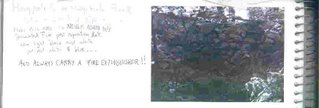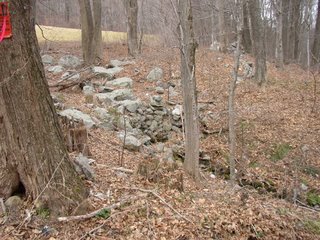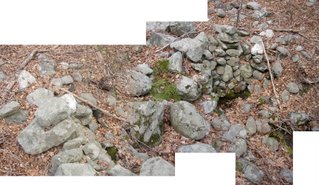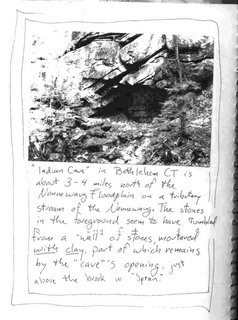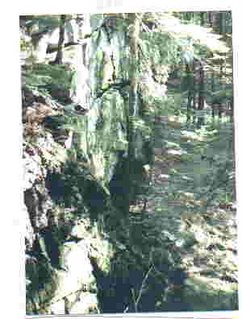
Wednesday, January 31, 2007
Turtles in my Logo

THE TORTOISE AS A SYMBOL.
Frank G. Speck’s "Delaware Big House Ceremony (1931)”

“Outlined in particularly high relief is the tortoise. In the latter creature we have the symbol of life, of perseverance, longevity and steadfastness. As the Delaware patriarch says, "The tortoise is the earth; is life." In the procession of time and among the elemental nature forces the direction of movement is from east to west, according to Delaware belief. So moves the tortoise with measured pace across the earth and through the Big House, carrying out the mythical allegory. At the end of his journey at the "western door," meaning where the sun sets at the edge of the earth, night will come to an end as does the ceremony after the twelveth night. Thus the tortoise "brings the ceremony." His shell in the form of the rattle is carried by the participants who take the part of leaders in the recitations and dances and move in the proper westward direction in the Big House. The saying is, as the ceremony is opened, and after the intervals of pause, "The tortoise is bringing us the worship and we are now ready to touch it again."
 The tortoise, moreover, is "he who carries our mother's body" - the latter being a metaphor for the earth. The tortoise being a "grandfather" thus becomes more ancient than the earth. The prominence of this mysterious creature in Delaware religious belief has long been noted by writers dealing with the tribe.
The tortoise, moreover, is "he who carries our mother's body" - the latter being a metaphor for the earth. The tortoise being a "grandfather" thus becomes more ancient than the earth. The prominence of this mysterious creature in Delaware religious belief has long been noted by writers dealing with the tribe. 
As early as 1670 the Delawares are recorded as declaring that all things came from the tortoise, that it brought forth the world, that from it's back a tree had sprung upon whose branches men had grown, that it had a power and a nature to produce all thing such as earth, and the like; that it brought forth what the supreme divinity wished through it to produce.
Zeisberger mentions the world-flood myth in which it is related that some human survivors took refuge on the back of a turtle whose age was so great that his shell was mossy. And the turtle represents the earth. His rounded back is to the Delawares the earth dome.
Another indication of a belief in the latent potency of the magical powers of this remarkable creature is met with in the esteem paid to the yellow color-pattern on the upper shell of the animal. Face paint patterns of a dignity appropriate to the men taking part in the Big House Ceremony are copied from these markings. The men wearing these patterns are adopting the symbol of the creature who "carries our mother's body."
 The creature that typifies the earth bearer designated as taxko/ xkc (fused together) in Delaware, and whose symbol exists in the form of the shell rattle, is the Box Turtle (Cistudo Carolina). This reptile is by the rulings of precise taxonomy not a tortoise but a connecting link between the aquatic turtles, or terrapins, and the terrestrial forms, the true tortoises. For the Box Turtles, of the genus Cistudo, deriving their name from the well known structure of the hinged plastron which permits the animal to withdraw the soft parts of it's body completely within the protective cover of the shell, have partially webbed feet, which places them nearer to the Turtles than the Tortoises. Yet to distinguish the reptile of Delaware tradition from the semi-aquatic American turtles, I have adhered to the designation of tortoise in the text and discussion.
The creature that typifies the earth bearer designated as taxko/ xkc (fused together) in Delaware, and whose symbol exists in the form of the shell rattle, is the Box Turtle (Cistudo Carolina). This reptile is by the rulings of precise taxonomy not a tortoise but a connecting link between the aquatic turtles, or terrapins, and the terrestrial forms, the true tortoises. For the Box Turtles, of the genus Cistudo, deriving their name from the well known structure of the hinged plastron which permits the animal to withdraw the soft parts of it's body completely within the protective cover of the shell, have partially webbed feet, which places them nearer to the Turtles than the Tortoises. Yet to distinguish the reptile of Delaware tradition from the semi-aquatic American turtles, I have adhered to the designation of tortoise in the text and discussion.Perhaps certain remarks offered by the informant will, in conclusion, add something to our idea of another side of the character of this knowing and potent reptile, so important to the religious sense of the Delaware.
He also adds:
SYMBOL OF THE TWELVE:
The Delaware also point out the occurrence of thirteen plates in the carapace and twelve in the plastron of all members of the American tortoises and turtles, bordered by the twelve marginal plates on each side. Another evidence in native thought of the tortoise as being a living symbol of the Universe. (Pg. 62)"
Frank Speck in "Delaware Big House Ceremony" 1931
Tuesday, January 30, 2007
 Dan's photo shows a "closer to the ground stone" below and a smoother shaped "low dome" stone carapace that makes me think "terrapin" or "snapper."
Dan's photo shows a "closer to the ground stone" below and a smoother shaped "low dome" stone carapace that makes me think "terrapin" or "snapper."
What Kind of Turtle Do I Have?
Copyright by Valerie Haecky (who writes:) "This document may be freely distributed for non-profit use, provided this notice is included."
...www.turtlecare.net/what.htm
"People often ask, what species of turtle they have, or even, whetherthey have a water or box turtle. The following guide is a quick way fordetermining some common types of turtles. It is essential for you tofind out what kind of turtle you have, since each type of turtle hasdifferent requirements. The following are two books that I use myself: "The Audubon Society Field Guide to North American Reptiles and Amphibians" by Bebler and King. ISBN 0-394-50824-6 "Turtles of the World" by C. H. Ernst and R. W. Barbour. ISBN 1-56098-212-8...
1. Scutes
And here’s a long list of names with links to all sorts of stuff from CNAH – the Center for North American Hereptology: http://www.naherpetology.org/nameslist.asp?id=7
Thursday, January 25, 2007
Nice To Be Mentioned
 It's nice to be mentioned in Rock Piles now and again.
It's nice to be mentioned in Rock Piles now and again.Like in the recent "Group Walk in Estabrook Woods:"
"... when I first explored Estabrook woods, I photo'd a large propped rock on a support boulder which looked like a turtle's carapace. Tim MacSweeney had some fun with that photo. "
I did have fun with that photo, afflicted as I am with Turtle Vision, possibly a form of mental illness - or perhaps not.
Here's what that was all about, the stone and the fun...

And Dan Boudillion had a photo of a very similar looking stone that at first glance I thought was the same stone!
These photos (and more rantings and ravings) were originally published at the NEARA website, under the title "Turtle Vision," as a "guest perspective."
"What you see is an illusion of what you see, until you learn to see what you're seeing."
There is a difference between a hallucination and an illusion...
Thursday, January 18, 2007
A Wall of No Great Importance

There are actually two adjoining stone rows in question. One is a linear row that joins a zigzag stone row, a row atypical of the incidental construction of zigzag row that results from stones being thrown up against a wooden “snake fence” that has long since deteriorated, as in described in books about stone walls by Eric Sloane and others..."





Tuesday, January 16, 2007
Oldddd Stufffff

"What looks like a rather nondescript, zigzag line on the skull of an extinct bison turns out to be an exciting bit of artwork: It apparently is the oldest painted object ever recovered in North America.
The forehead of the skull was decorated with a jagged, reddish line sometime between 10,200 and 10,900 years ago, reports archaeologist Leland Bement of the Oklahoma Archeological Survey.
The unique specimen was recovered from a bone bed at the site of a Folsom-culture buffalo kill in northwestern Oklahoma. Bement said the painted skull was placed near the entrance of the kill site, perhaps to ensure the success of future hunts. The paint, made of a locally available iron mineral, was preserved for 10 millennia because the skull was quickly covered by the carcasses of bison killed during a subsequent hunt. The good-luck charm apparently worked."
M DK
Current Research in the Pleistocene 14:6-9 (1997)
Leland C. Bement, Marian Hyman, Michael E. Zolensky, and Brian J. Carter
"An extensively trampled bison skull from the contact between two of the three bone beds at the Folsom-age Cooper site in NW Oklahoma has a red zigzag line 5cm long and 4mm wide painted on its frontal (Figure 1). The line traverses the frontal suture, and paint is deposited on the open suture walls. A second area of paint lies 1.5 cm anterior of the first. Its extent is unknown due to damage from trampling. Taphonomic and site formation analyses suggest the skull was painted just prior to the second kill, after natural decay had cleaned and bleached the skull's surface (Bement 1994). The success of the second kill is amply indicated by the bison skeletons overlying the painted skull and extensive damage by trampling."
http://members.tripod.com/~fclark/creative_corner/fern_cave.html
Dr. Edwin James (1830)
“It must have been early spring when we arrived at Saugenong, for I can remember that the leaves were small and the Indians were planting their corn. They made me help in their labors. After the planting they all left the village and went out to hunt meat and dry it, and they took me with them.
When they came to their hunting grounds, they chose a place where there were many deer. Here they built a long screen, like a fence, of green boughs and small trees. The Indians were to shoot the deer from one side of it, and they showed me how to remove the leaves and dry brush from that side. I sometimes had the help of the squaws and children in this work, but at other times I did it alone.”
The Occasional Chestnut Rail


I posted up a “soon come” photo – a photo of a notebook page – and wrote that I wrote down the wrong name of the road in the sketchbook. Well, I didn’t; there is another of the multiple “town line roads” surrounding me in four or five different places (including even an “old town line” road or two) that have some zigzag stone rows with rails on top of them.
And the stones are testudinate – shapes reminiscent of turtles – and I’m sure it was easier to leave the stones in place and then turn a trail into a road that used to go to an artist’s colony way back in history and then turn back into a wood road that eventually reverts to a tractor road that eventually turns into a trail that now opened back up as an ATV and dirt-bike race track (they never drive slowly, do they?) that eventually someone will get seriously hurt or killed on.
And there’s hammer stones and shaft abraders and those stones with the depressions worked into them to crack nuts just sitting there on the rows, along with old bottles, cans, tail pipes, tires, snuff and kerosene cans as well as spent shot gun shells etc.
One of the other places with rails on zigzags is across the road from my cousin’s former house – before she moved to the house where, out by the entrance of her driveway, there used to be Pomperaug’s Memory Pile - that I think I posted a woodcut of, either here or at Rock Piles.
This particular zigzag row remnant, like the zigzag row remnant that is along the road by my house, is disturbed at its southern end by the old poor house or work farm of the late 1700’s, where all kinds of linear and rectangular and definitely colonial sorts of stone work abound.
Sometimes the "difficult to capture (in photos) zigzag rows" aren't difficult to capture under certain conditions and here's one that didn't get away...
Friday, January 12, 2007
Bad Scanner day
It's frustrating.
So how about this:
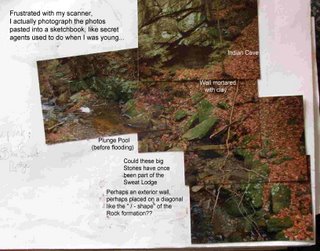
Here's some stone worked spring things:

I did actually date the Spring dicovery as sometime in August 1997...
... the hillside above this spring is all terraces with stone rows on top of them, springs and outcrops linked by mostly linear - as opposed to zigzag- stone rows, which I mention because the Rock Piles post of yesterday asks, "Where else are similar rows (Etc)."
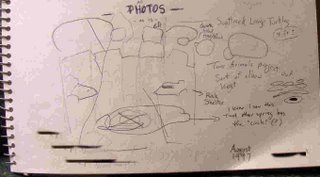
Here's a much more simple spring near "The Wigwams."

I think I once sent Norman or Peter (or both) a copy of this photo because he had photographed a similar one. Maybe I didn't because the scanner was acting up...

Here's a "Soon Come" future post I'll put up. Seems I wrote myself a note in Sept. 1997 to go back and check out a place (that I wrote down the wrong name of the road). Almost 10 years later I took some photos...
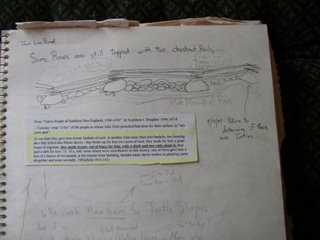
Thursday, January 11, 2007
The Stone-worked Spring
 This is on another river on the opposite side of town from me. There's lots of stone remnants there too, including this "Stone-worked Spring on Hooppole Hill" whose name suggests "a place where coopers cut hickory bands for their barrels."
I "found" the Spring perhaps in 1997 0r 1998 - my notebook has no dates on my drawings and rubber cemented photos. A client, of an antique dealer for whom I did lots of work, was having a wedding and I was to wax and touch-up every bit of furniture in the very large house. It involved some "drying time," so I took some "off the clock" breaks to wander the many stone rows on the property, camera in hand. I took lots of photos because there was all sorts of interesting things going on - terraces and ancient trees, stone worked springs and even more stone worked springs.
Here's a surviving photograph, scanned from the notebook:
This is on another river on the opposite side of town from me. There's lots of stone remnants there too, including this "Stone-worked Spring on Hooppole Hill" whose name suggests "a place where coopers cut hickory bands for their barrels."
I "found" the Spring perhaps in 1997 0r 1998 - my notebook has no dates on my drawings and rubber cemented photos. A client, of an antique dealer for whom I did lots of work, was having a wedding and I was to wax and touch-up every bit of furniture in the very large house. It involved some "drying time," so I took some "off the clock" breaks to wander the many stone rows on the property, camera in hand. I took lots of photos because there was all sorts of interesting things going on - terraces and ancient trees, stone worked springs and even more stone worked springs.
Here's a surviving photograph, scanned from the notebook:
Pretty bad... old film and no fire extinguisher.
I'll explain; I was in the process of moving stuff from a room in my house to the barn when I realised I needed to pick up my daughter. I parked very close to the Home of a Antique Dealer where she was working, filling in for her friend who regularly did cleaning there. Then I drove up to the Hill to remove some clamps and finish up the last piece of furniture I was working on, parking right next to a gigantic barn full of exercise equipment and stuff. Then I drove my mobile workshop down the hill to the Spring I wanted to photograph with some old film I was taking a chance on being good still, planning to drop my daughter and my two dogs back home before dropping off the exposed film to be printed and bringing my video camera to the repair shop and making a deposit at the bank and probably 27 other things I had to do.
While I was taking pictures, I turned to my daughter to ask her to get into the photo for some size perspective, but she looked at me wide eyed, struggling to speak and instead just pointed to my van. A stream of burning gasoline was dripping from under my engine and running down hill underneath the length of the vehicle. About 30 seconds later, time enough to get the dogs out the back doors, the van was pretty close to totally engulfed in flames.
I quickly replanned my day and ran to a house to call the fire department...
So I finally went back on January 10, 2007 and took these new photos.
In the top left you see the edge of several acres of hayfield; to the top right the lowest of terraces marked by a stone row, perhaps originally connected to the Spring.
At bottom right is the stream that flows out from the Stoneworked Spring...


Details:
To me it seems to be stone effigies, mostly turtles, that are incorporated into the design of the Stone Worked Spring. Some faces are quite striking, some carapaces very large while others are small, and I see different forms every time I look...
And an old picture, carapace and head stone.
I couldn't find it yesterday...
Wednesday, January 10, 2007
“Aquêtuck !”
“Wunnóhquand auntau,”
The Peace Spirit Speaks;
“Wunnand auntau,”
The Good Spirit Speaks:
“Aquêtuck !”
Let this warring cease!
“Tuppaûntash !
You—consider my words !
“Mishaúntowash !”
You—speak out !
Wunnétu ntá
My heart speaks the truth
- the whole world before long shall be burnt
God commands,
"Cuppittakúnnamun wèpe wáme,"
That all men now repent,
“Nisquanemanit auntau:”
The Spirit of Mercy Speaks:
“Aquêtuck !”
Let us cease this warring !
“Aquêtuck !
Aquêtuck !”
“Kummoúwinneem aquéne–ut”
We gather in peace
“Popowuttáhig nanátowash !”
Let the DRUM truly speak !
“Wunnóhquand auntau,”
The Peace Spirit Speaks:
“Aquêtuck !”
Let this warring cease!
Aho!
Aho!”
Written January 10, 2007, just before I turned 51 years old, about 12 hours before a televised speech is “unveiled” (as if it’s not totally transparent) announcing a “Surge” rather than an “Escalation.” It’s my birthday and I can make my own speech!
The poem was created by pasting in words and their translations as put together at: http://www.geocities.com/bigorrin/waabu10.htm - “Spirit Names and Religious Vocabulary” by Dr. Frank Waabu O'Brien, Aquidneck Indian Council, where in the footnotes I find:
“Oral tradition speaks of the constant warring between ‘Wunnand” and “Mattand - the Spirit of Evil.” and the rituals and ceremonies to find the balance between these two forces in the natural, preternatural and supernatural realms of being and doing.
(Dr. Frank Waabu O'Brien)
And:
“Taupowaüog…they make solemne speeches and orations, or Lectures to them, concerning Religion, Peace, or Warre and all things”
(Roger Williams, 1643, p. 128).















